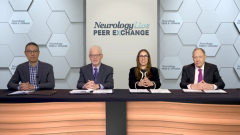
Overview of Neuromyelitis Optica Spectrum Disorder (NMOSD)
Aaron Miller, MD, FAAN, provides an overview of neuromyelitis optica spectrum disorder (NMOSD).
Episodes in this series

Brian Weinshenker, MD: Hello, and thank you for joining this NeurologyLive®program titled “Updates in the Management of Neuromyelitis Optica Spectrum Disorder Care,” also known as NMOSD. I’m Dr Brian Weinshenker. I’m a professor in the Department of Neurology at the University of Virginia in Charlottesville, Virginia. And I’m joined today by Dr Flavia Nelson, who’s chief of the multiple sclerosis division at the University of Miami at the Miller School of Medicine in Miami, Florida, Dr Robert Shin who’s professor in the Department of Neurology and director of Georgetown Multiple Sclerosis and Neuroimmunology Center at the Georgetown University in Washington, DC, and Dr Aaron Miller, who’s the professor of neurology at the Icahn School of Medicine at Mount Sinai and medical director of the Corinne Goldsmith Dickinson Center for Multiple Sclerosis in New York City. Today we’re going to provide an overview of neuromyelitis optica spectrum disorder and discuss recent approvals of treatments and updates in the treatment and management of this condition. Thank you very much for joining us and let’s begin.
Dr Miller, I’m going to start with you. What is neuromyelitis optica spectrum disorder, and can you tell us how its characterization over the last 20 years has changed your approach to patients you see with new symptoms suggestive of MS [multiple sclerosis]?
Aaron Miller, MD, FAAN: I’ve been dealing with neuromyelitis optica spectrum disorder and calling it something else for years because it was previously thought to be a variant of multiple sclerosis, as you well know. Since the discovery of the aquaporin-4 [AQP4] antibody, we know that it’s a distinct disease. So, for the most part, NMOSD is a disorder driven by the pathogenic effects of anti-aquaporin-4 antibody. About 80% of them are positive. I’m not quite sure what the pathogenesis is of many of the others, but for the most part, they’re antibody driven by that antibody. And this is a clinical entity that has a number of core features.
The big 3 are optic neuritis, which has some characteristic distinctive features compared to other causes of optic neuritis; a myelitic picture that is characterized by longitudinally extensive lesions, in most cases, and that accounts for about 85% to 90% of the initial presentations. The third member of the so-called big 3, or the hallmark clinical conditions, is an area postrema syndrome in which patients get intractable nausea, vomiting, and hiccups.
There are 3 other entities that are considered core characteristics. These include diencephalic syndrome which might include narcolepsy, for example, symptomatic brainstem syndromes and some unusual cerebral presentations which are accompanied by unusual cloud-like lesions on the brain MRIs. And, as I said, most of those patients will be diagnosed because they have a positive aquaporin-4 antibody.
Brian Weinshenker, MD: OK Aaron. So, I gathered the distinguishing NMOSD from MS depends on antibodies, but also clinical features. You mentioned a number of attacks like narcolepsy. We don’t see those in MS, and I think that’s by certain radiology findings as well?
Aaron Miller, MD, FAAN: So, as you said, some of these syndromes clinically overlap with MS-related syndromes. So optic neuritis is very characteristic in MS as well, but the lesion distribution in the optic nerves is quite different. MS tends to have short segment lesions in the middle of the optic nerve, whereas the optic neuritis associated with NMOSD is typically long-segment posterior, often going back to the chiasm, sometimes involving both nerves at the optic nerves at the same time. Clinically, in MS, we tend to see relatively mild visual impairment and good recoveries, whereas with NMOSD the visual acuity loss is often very severe during the attack and there’s very frequently incomplete recovery from that attack.
The transverse myelitis doesn’t necessarily differ very much clinically from that in MS, but it is accompanied, in most instances, by longitudinally extensive lesions on the MRI. That means lesions that extend over at least 3 vertebral bodies. That’s not invariably the case. You can see short-segment lesions, but as a rule you’ll see these long lesions. And then of course, the area postrema syndrome is not something we see in MS. And this accounts for maybe 4% of the presenting episodes of NMOSD.
Transcript edited for clarity
Newsletter
Keep your finger on the pulse of neurology—subscribe to NeurologyLive for expert interviews, new data, and breakthrough treatment updates.





























